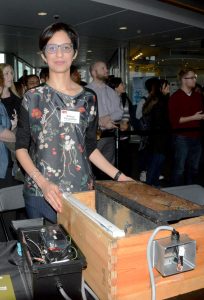SFU Mechatronics grad protecting bee hivesSFU Mechatronics grad protecting bee hives
“If the bee disappeared off the surface of the globe, then man would have only four years of life left. No more bees, no more pollination, no more plants, no more animals, no more man.” Albert Einstein.

In Canada, and the Fraser Valley in particular, agriculture is a big part of the economy, much of which hinges on a healthy population of bees to pollinate the crops each year.
Bees are critical in keeping Canada number one in the world for canola production, second in the world for blueberry production and 16th in the world for apple production. We have a lot riding on the wings of these incredible creatures that are vulnerable to disease, infestations and damaging environmental factors.
Oldooz Pooyanfar, a graduate student in Mechantronics Systems Engineering (MSE) program at Simon Fraser University in Surrey, is doing something about safeguarding the bees. She is designing a high tech system which allows for the monitoring of bee health in the hive, without disturbing the hive.
“The project arose after a beekeeper approached the program to find better ways of monitoring bee colonies,” Pooyanfar said. Physically inspecting a hive results in a 24 hour interruption in production of honey which has a physiological impact on the colony and an economic impact on the operator.
“We’re installing sensors to monitor vibration, sound, humidity and temperature to observe the brood hive which is where the queen is,” Pooyanfar explained at the unveiling of the new Metatronics Centre at Surrey’s SFU Campus. “We’ll look for patterns that could alert us to changes in the hive such as infestations, or if the queen dies, any abnormalities that would let the beekeepers know without then having to physically check the hives. There are a lot of diseases which can cause the colony to collapse. And in winter it’s harder to monitor because they’re covered, so with the sensors we can look for abnormalities and then alert the beekeepers.”
Pooyanfar said that the program is currently working out of Honeyview Farms in Chilliwack,
and estimates that it might be a year or so before the program is ready for prime time.
“We have to collect the data for the whole year, but after that we’re just hoping to give it to as many beekeepers as possible. The more who are involved, the better the data, and our predictions can be better.”
Did you know: There are approximately 7,000 beekeepers in Canada operating a total of 600,000 colonies of honeybees. According to the Canadian Honey Council, we produce 75 million pounds of honey annually. Approximately approximately two-thirds from the prairie provinces, one third from rest of country. Half of all honey produced is exported, 80-90% is exported to the USA. The estimated value of honey bees to crop pollination in Canada is over $2 billion.









